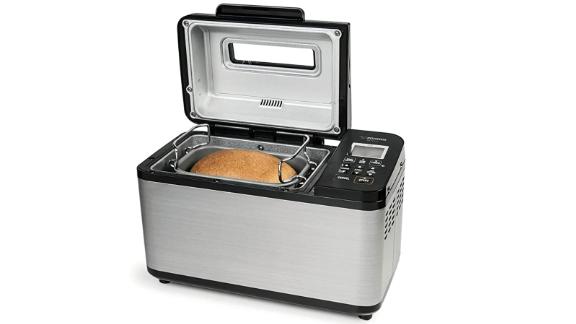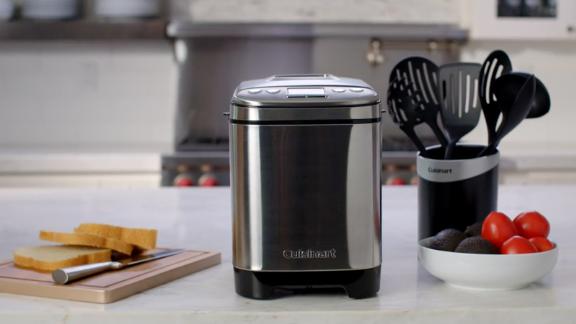Best bread machines 2021 | CNN Underscored
[ad_1]
(CNN) —
If quarantine taught us one thing, it’s that stress baking is real. And a bread maker is a great tool for novice bakers looking to turn out great loaves without a lot of fuss.
We tested eight bread makers, ranging in price from $75 to $340, baking dozens and dozens of loaves of white, wheat and gluten-free bread. We assessed those loaves for taste, texture and shape, as well as the evenness of the rise and crumb and the crispiness and color of crust. In the end, besides packing on several extra pounds as our carb intake soared, we came up with two clear winners:
The Zojirushi Home Bakery Virtuoso Plus Bread Maker delivered by far the airiest, tastiest and prettiest white, wheat and gluten-free loaves. And unlike every other model, it makes a familiar, horizontally shaped loaf. Also unique among the models we tested, the Zojirushi is customizable, offering experienced bakers the ability to program their own settings. At $340, is it an investment? Yes. But coming home to fresh, bakery-worthy bread after a long day of work? Priceless.
Baking novices on a budget or those who have limited counter space can’t go wrong with the Cuisinart CBK-110 Compact Automatic Bread Maker. It turned out airy and high loaves with smooth domed tops and even crumbs and crusts. The overall taste and texture of the loaves wasn’t on par with the more expensive Zojirushi Virtuoso, but it’s a relative bargain, its compact footprint makes it small-kitchen-friendly and it was the smallest and lightest bread maker we tested, making it easy to stow away when not in use.

Zojirushi
Zojirushi Home Bakery Virtuoso Plus Bread Maker
Specifications
- 10.5 inches by 18 inches by 13 inches; 24 pounds
- 1 loaf size (2-pound)
- 3 crust colors (light, medium and dark)
- 14 preprogrammed bread settings (white, whole wheat, European, multigrain, gluten-free, salt-free, sugar-free, vegan, rapid white, rapid whole wheat, dough, sourdough starter, cake and jam) and three user-programmable custom settings
“This bread is amazing,” one of our tasters gushed as he popped — OK, shoveled — a slice of fresh, warm white bread made in this Rolls-Royce of bread makers into his mouth. Then he and our other tasters went on to swiftly inhale the rest of the loaf in competitive food-eater time.
The Zojirushi Virtuoso Plus is expensive for sure, but in this case, you get what you pay for. Each loaf we baked turned out beautifully, as if it came straight from our favorite bakery, with a crisp, golden-brown crust; soft, even crumb; perfect rise; airy, fluffy texture; and delicious taste. Other machines may have produced a nice white, a respectable wheat or a tasty gluten-free version, but only the Virtuoso was tops on all three.
While all the other models tested feature vertical pans, which make a tall, skinny loaf, the Virtuoso’s horizontal 9-inch-by-5-inch pan turns out loaves like those sold in stores and bakeries. And with room for dual paddles as well as dual heaters (one on the bottom of the machine and another in the lid), the Virtuoso mixed ingredients and kneaded dough more effectively and baked and browned more evenly than the other machines we tested. It’s also quieter in operation than the competition.
While the Zojirushi only makes 2-pound loaves (other machines we tested let you bake 1-, 1.5- or 2-pound loaves), it lends creative bakers more flexibility with three customizable “homemade” settings. Also unlike most models we looked at, it stops kneading when you open the lid, which makes it easy to add mix-ins or scrape down the sides.
The main drawback to this stainless steel machine? Its size and weight. At 10.5 inches by 18 inches by 13 inches and 24 pounds, you’ll need plenty of counter space or ample storage space to stash it. It also only has a one-year warranty (three years was the longest warranty offered among the machines we tested), but replacement paddles and pans are readily available.

Cuisinart
Cuisinart CBK-110 Compact Automatic Bread Maker
Specifications
- 10.25 inches by 13.25 inches by 11.25 inches; 11 pounds
- 3 loaf sizes (1-, 1.5- and 2-pound)
- 3 crust colors (light, medium and dark)
- 12 preprogrammed bread settings (white, French, whole wheat, ultra-fast, sweet, gluten-free, artisan dough, dough, jam, packaged mix, cake and bake)
An excellent choice for those with small kitchens, the CBK-110 has a smaller footprint and is lighter than most other machines we tested, making it easy to stow away when you aren’t using it. More importantly, the bread we made with it was yummy. Our white loaf had an even, golden-brown crust, a smooth domed shape, a nice even crumb and a fluffy texture.
The wheat bread showed similar results, though we found it to be denser than those made using the Zojirushi. The gluten-free loaf, while tasty with a nice taste and crust, did collapse on us. When using bread machines, it’s important to note that some recipe tweaks will be necessary. According to the blog Bread Machine Diva, too much liquid can cause bread to collapse, as can too much or too little yeast or not enough salt or flour. Making even the slightest adjustments can be the difference between a beautifully domed top and one that’s sunken in.
During its mix and kneading cycles, the Cuisinart was louder than most models, possibly a factor if you want fresh bread for breakfast, as depending on how close your bedrooms are to your kitchen, the noise could wake the house hours before the alarms are set to go off. Its 4-foot cord (the longest we tested; most were 3.3 feet) simplifies placement for a machine that’s likely to be used and then put away, and along with the other Cuisinart model we tested, it had the best warranty at three years.
If you’re a baking newbie looking for a machine that’s affordable and compact and are willing to experiment a bit to dial in your results? What are you waiting for? Order the Cuisinart CBK-110 now.
To hunt down the best bread makers on the market, we researched models that were highly rated by users, top sellers at major retailers and well reviewed by professional critics, eventually homing in on eight models to put to the test. For each bread maker, we made three loaves — white, wheat and gluten-free — using the recipes for each provided with the machine. If a loaf turned out seriously undercooked, deflated or misshapen, we baked it again to ensure a mismeasurement of ingredients wasn’t to blame.
It’s also a good idea to check the bread during the kneading cycle (lifting the lid is fine). Dough looking overly wet? Add a bit more flour to help keep it from collapsing later on. Does it seem too dry? Pour in a teaspoon or two of water to keep it from ending up too dense.
We noted everything from ease of use to number of settings to noise levels to counter appeal and, most importantly, the bread’s ultimate texture and taste. We used the following criteria to assess each bread maker:
Function
- Baking results: For each machine, we used the provided recipes to bake white, wheat and gluten-free loaves. We then evaluated each loaf’s crust, rise of the bread’s dome, crumb, overall texture and flavor.
- Settings/controls: We took note of the number of available bread settings, also called courses (i.e., white, wheat, gluten-free, multigrain, etc.) as well as crust options (such as light, medium or dark), loaf sizes, timers and any other controls, giving more points for more options.
- Delayed start/auto off: All the machines tested included delayed timers and one-hour warming features, but length of delay and functionality varied somewhat between bread makers. We took note of how each worked.
- Included accessories: Kneading paddles came with all the bread makers, but some included more than one. We also noted other included accessories, such as hook tools to remove the paddles from the loaves, measuring cups, measuring spoons and fruit and nut dispensers.
- Ease to clean: When testing, we assessed how easy it was to clean the bread pan, paddle and inside and outside of the machine.
- Unique features: We took notes on any added features or settings and assessed whether they were actually useful or just for show.
Build
- Overall build: We noted the quality of materials used to make each bread maker.
- Size: We measured each machine by length, width and height, noting how much space each took up on the kitchen counter.
- Weight: We weighed each bread maker, assessing whether it was heavy to move or, conversely, seemed too lightweight to be durable.
- Loaf capacity: For each machine we took notes on the available loaf capacity, giving more points to machines with larger loaf capabilities and multiple loaf size options.
- Design: We assessed the overall design of each machine, including whether the buttons/settings were intuitive and well placed, features such as LED screens and viewing windows, how it looked on the counter and how well it would complement various decor styles.
- Cord length: We measured each machine’s cord, noting whether it was too short or too long and if the cord could be stored away.
- Noise level: We noted how loud each machine was during the kneading stage, along with any beeps and clicking sounds made.
- Warranty: We looked at the length of the warranty for each device, adding more points for longer warranties.
Zojirushi Home Bakery Maestro Bread Maker ($325.99; amazon.com)
Zojirushi’s compact Maestro offers most of the features of the Virtuoso Plus, though it only produces a 1-pound loaf, good for singles or couples but too small for families. A handle makes it easy to move from cupboard to counter, and though it lacks the dual paddles or heaters of its larger cousin, it adds an automatic fruit and nut dispenser. Results were almost as good as with the Virtuoso, though crusts were not as crisp. Also we love that it plays a whimsical few seconds of “Oh! Susanna” when it starts and “On the Bridge of Avignon” when it’s done baking.
Breadman BK1050D Bread Maker ($129.99; amazon.com)
Unique to the Breadman is a collapsible kneading paddle that is supposed to prevent a hole or indent from forming in the bottom of the bread. That didn’t make a difference during our testing — the paddle still got stuck in the bread with each loaf we baked. As for bread quality, the gluten-free was our favorite behind the two Zojirushi models, with an airy texture, an even crumb and a crisp golden crust. The white bread was also quite good; however, the wheat was dense and just so-so. A fruit and nut dispenser also allows for easy mix-ins.
Oster Bread Maker With ExpressBake ($99.99; amazon.com)
Oster’s compact aluminum model offers an express setting that turns out a fresh loaf in one hour or less. At a mere 8 pounds, it was the lightest model we tested. For consistency of testing, we used the traditional settings and found the white bread turned out the best — it was light with a golden, medium-crisp crust but also had a fairly large air pocket that ran the length of the loaf that left big holes in most slices. The wheat resulted in a nice shape but was dense and dry, and the gluten-free loaf came out quite undercooked.
Cuisinart CBK-200 Convection Bread Maker ($159.95, originally $235; amazon.com)
One of the largest (and loudest) bread makers we tested, out of the box, the Cuisinart CBK-200 has a convection feature that circulates air for more even and faster baking. This machine produced evenly risen white and wheat loaves, with nice shapes and crispy, golden crusts, but the gluten-free loaf collapsed and was underbaked in the center. At about $70 less, we prefer the compact Cuisinart.
Hamilton Beach Bread Maker ($63.47, originally $74.99; amazon.com)
We weren’t able to get good results from the inexpensive Hamilton Beach machine. The white loaf was OK — decent shape, but it lacked a golden-brown crust, was on the dense side and tasted rather bland. The wheat loaf, meanwhile, came out oddly shaped and was so dense it could have doubled as a brick. The gluten-free version somehow was both dense and underbaked in the center — we took a nibble and tossed the rest. It is inexpensive and has a small footprint, but it might only be worthwhile if you’re on a very strict budget.
KBS Pro Bread Machine ($129.99; amazon.com)
The KBS has a removable nuts and fruit dispenser that it claims uses smart technology to dispense your ingredients at the right time, and offers a range of courses including rice wine and stir-fry modes. But even though the bread it produced was light and fluffy with a pretty even crumb, the crust could have been crisper and all the loaves we baked collapsed. One of the noisier models we tested, it also left some flour on the outside of the wheat loaf, which is easy enough to scrape off but should have been completely mixed in.
Read more from CNN Underscored’s hands-on testing:
[ad_2]
Source link









